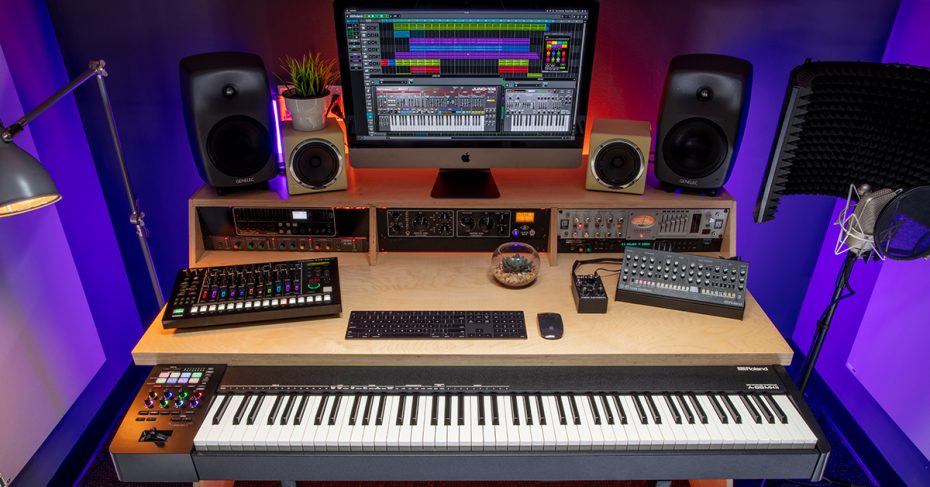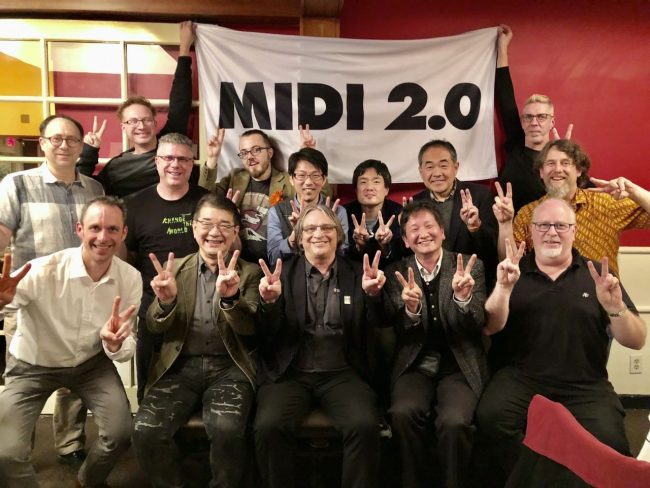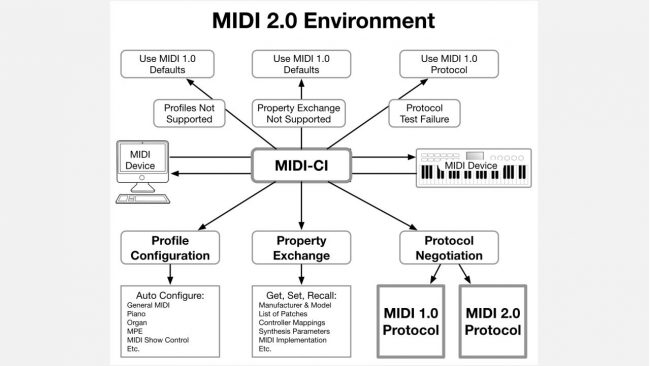
MIDI 1.0 changed the world of music — and the aftershocks are still being felt. When two synthesizers were connected at Winter NAMM in 1983, few (if any) people anticipated that MIDI would be the control infrastructure behind hit Broadway plays like Miss Saigon, would time the fountains at the Bellagio Las Vegas hotel, and would be incorporated into billions of smartphones around the world.
One reason for MIDI’s success — perhaps the main reason — is that it was truly a cooperative, industry-wide effort, spearheaded by companies who sometimes were bitter rivals. The industry knew that MIDI would succeed only if it was universal and that it had to erase — not add — boundaries among pieces of gear from different manufacturers. When you think of how format wars in other industries have led to confusion and no format becoming dominant, MIDI’s adoption becomes all the more remarkable.
There are plenty of sources for information about MIDI 2.0’s technology, particularly at midi.org, The MIDI Association’s (TMA) free website. Registering with the TMA (which is also free) allows anyone to download the core MIDI specifications. So, let’s leave the rocket science to others and talk about what MIDI will mean to you now and in the years ahead.
Musicians often ask why it took so long for MIDI 2.0 to appear. Of course, part of that is because MIDI 1.0 was a forward-looking spec that remains relevant to this day. But, MIDI 2.0 did not come about haphazardly. Although the MIDI Manufacturer’s Association (MMA) and AMEI, the Japanese equivalent, are the most visible stewards of the MIDI spec, internally, there are multiple technical working groups that are responsible for making sure that everything “just works.” It took well over a decade to get where MIDI 2.0 is now; for example, the aspects of MIDI 2.0 that address higher resolution are based on the work of a group that spent years forging an HD (high-definition) element of the MIDI spec. MIDI 2.0 is the result of not only the efforts of the largest manufacturers of MIDI gear but also individual MMA members, no matter the size of the company (fig. 1).

Oh No! All My Gear Will Become Obsolete!
No, it won’t! MIDI 1.0 remains valid, and your existing MIDI gear will continue to function within the MIDI 2.0 world as it does now. Because MIDI 2.0 coexists well with MIDI 1.0, it’s likely MIDI 1.0 devices will continue to be produced in the future if MIDI 2.0’s features are not needed for a particular application. In developing MIDI 2.0, backward compatibility with MIDI 1.0 was always a priority.
MIDI 2.0 is not about replacing the original specification but about adding features that enhance the spec with features users have wanted almost since MIDI 1.0 appeared. The technology of 1983 wasn’t up to those tasks, but technological advances that have occurred over the past 37 years allow MIDI to go much further.
MIDI 2.0’s main advantages involve smoother workflow and higher resolution for greater expressiveness. MIDI 2.0 is a deep, forward-thinking specification. There are elements that are ideal for controllers that haven’t even been invented yet — but when they are, MIDI 2.0 will be ready. Remember, MIDI 1.0 products didn’t have to implement all aspects of MIDI, and MIDI 2.0 is the same way. MIDI 2.0 products will roll out over time, implement MIDI 2.0 features that are appropriate, and integrate with your existing system. Also like MIDI 1.0, there will almost certainly be applications in the future that no one is anticipating now.
Interestingly, some of these changes are theoretically possible to apply to MIDI 1.0 devices. With appropriate retrofits, some MIDI 1.0 devices may allow for compatibility with selected aspects of the MIDI 2.0 specification.
MIDI Becomes a Two-way Conversation: MIDI-CI
MIDI 1.0 was tied to a hardware-based serial interface that, by today’s standards, was slow and inefficient. Hey, it seemed like a good idea at the time — and realistically, it was the only option available at the time. MIDI 1.0 simply didn’t have the bandwidth to allow for enhancements like high-resolution controllers. Furthermore, a MIDI cable either transmitted or received data — it couldn’t do both. Specifying MIDI over USB was a definite improvement, but MIDI 2.0 finally turns MIDI from a monolog into a dialog. MIDI 2.0 gear will be able to talk to other MIDI gear over a variety of interface protocols, not just USB.
A key element of this dialog is MIDI Capability Inquiry, also known as MIDI-CI (fig. 2). The concept seems deceptively simple: MIDI gear can talk to other gear and find out about its functionality. But the implications are huge.

MIDI-CI is what allows for backward compatibility. A MIDI 2.0 device can ask another device if it speaks MIDI 2.0. If so, they can converse. If there’s no answer, the MIDI 2.0 device will fall back to using MIDI 1.0 with that device. Of course, this doesn’t allow the MIDI 1.0 device to acquire MIDI 2.0 magic powers any more than plugging a USB 2 device into a USB 3 port increases the USB 2 device’s speed, but it’s what lets your MIDI 1.0 gear function in a MIDI 2.0 ecosystem.
Another implication is the end of tedious MIDI mapping. For example, if you connected a hardware control surface with 16 faders to a synthesizer, the control surface wouldn’t know what it was controlling, and the synth wouldn’t know it was being controlled. If you were lucky, something like the ancient (but durable) Mackie Control protocol might be applicable to do the parameter mapping for you. But in a lot of cases, you had to do the work — and it was tedious to map, for example, the faders in Peavey’s cool PC-1600 fader box to control software faders for live performance. I look forward to leaving those days behind.
In addition to streamlining workflow, interactivity could mean more flexible ways of dealing with improvisation. Many acts already sequence live performances with mix automation, program changes, and clock messages, but this requires adhering to specific timings and cues. MIDI 2.0 enables a high degree of potential flexibility. For example, perhaps a performer could trigger a command like “repeat this section again” simply by tapping a footswitch for a program change that’s already selected then double-tapping it to resume the existing sequence.
MIDI-CI’s Nuts and Bolts
The MIDI-CI spec has three main elements: Profile Configuration, Property Exchange, and Protocol Negotiation.
Profile Configuration
Profiles define the rules by which MIDI equipment communicates. For example, a MIDI 2.0 synthesizer could have an analog synth profile. When a hardware control surface queries the synthesizer (“Hi! I’m a MIDI 2.0 control surface. Nice meeting you! Who are you, and what do you do for a living?”), upon receiving the response, the control surface would automatically map its controls in a way that made sense for controlling an analog synthesizer. (If you’re familiar with Native Instruments’ NKS, the result is similar — you don’t have to think about what to do with the hardware to control the software.) If you then decided to use a different analog synthesizer, the control mapping would be the same. Think of Profiles as an automatic, turbocharged version of MIDI Learn — except you don’t teach it, the MIDI 2.0 gear does.
Property Exchange
This helps bring hardware into a software environment. Conceptually, it makes hardware seem more like a software plug-in because a DAW can query the hardware synth and find out its properties (like controller names, patch names, metadata, and the like). These can then be part of a device setup that’s stored within a DAW’s project file, where the various synth parameters — defined clearly and unambiguously — would be accessible from within the DAW itself. Because of MIDI 2.0’s two-way communication, simply connecting a hardware synth to your DAW would “feel” like inserting a plug-in. This is a much clearer, and more universally applicable, solution than using traditional System Exclusive messages.
Property Exchange also defines how Property Exchange-compatible hardware and software can autogenerate editors and preset creation tools. The universality of devices based on Property Exchange means they’re inherently “cross-platform” and could work just as easily with Windows, Mac, Linux, iOS, Android, and web browsers. Also note that Property Exchange messages use JSON (JavaScript Object Notation) for data exchange, which is a human-readable format — not arcane code.
Protocol Negotiation
This determines whether a MIDI device can accommodate the higher-resolution controllers, greater number of channels, and other enhancements we’ll cover next. For example, a high-resolution MIDI 2.0 keyboard controller can query whether a device can handle higher-resolution controllers and velocity data and, if not, fall back to MIDI 1.0 protocols. Bear in mind that this all happens automatically. If you use a MIDI 1.0 controller with a synthesizer that has MIDI 2.0’s increased resolution, you’ll simply have MIDI 1.0 resolution, not some kind of error message or show-stopping incompatibility.
Increased Expressiveness
Musicians have wanted better resolution, and more expressive control, almost since MIDI 1.0 was introduced. Back in those days, the data streams required for a protocol like MIDI Polyphonic Expression (MPE) would have brought most computers to their knees — it was a world where 32-bit processors like the 68000 maxed out at 8MHz and your computer’s memory was measured in kilobytes, not megabytes (let alone gigabytes).
In a way, MPE was the first salvo of MIDI 2.0. MPE is a crucial part of new, more expressive electronic controllers like Roger Linn’s LinnStrument and the ROLI keyboards such as the Seaboard Rise. The ability to wiggle, slide, press, touch, and strike to control individual pads or keys — polyphonically — far exceeds MIDI’s previous combination of velocity and aftertouch.
MIDI 2.0 expands on this further by reimagining the role of controllers. One of the main differentiators of analog synthesizers is the smoothness you feel when rotating controls; with digital gear, it’s sometimes obvious that controls are quantized into steps. Various workarounds have been created over the years, like interpolating MIDI-controller messages to obtain more resolution, but these never became an official part of the MIDI specification.
With MIDI 2.0, controllers now offer 32-bit resolution — a huge improvement over the current 128 steps, which result from 7-bit resolution. Velocity has been upgraded from 7-bit to 16-bit messages. The cumbersome, compound RPN (Registered Parameter Number) and NRPN (Non-Registered Parameter Number) controller messages have been replaced by single controller messages that are as easy to use as MIDI 1.0’s Control Change messages. This is important because the number of registered and assignable controllers has been expanded to 16,384 each (over 32,000 total), so even with layered, polyphonic control surfaces, you won’t run out of controllers. There’s also space reserved for hundreds of new MIDI messages, which will be ready and waiting when technologies like virtual reality require messages that, at present, we don’t even know we’ll need — but it will be fun when we find out why!
The new spec even allows for per-note controllers, so that when you hit a key or playing surface, the controller can define how that particular note should respond. Think of this as the digital equivalent of holding a bow differently when playing different cello notes or like changing the pick angle when plucking a guitar string (note that Steinberg’s Note Expression feature has already provided the “proof of concept” for why per-note expression is useful). Per-note controllers offer the same kind of expressiveness as MPE, but they do so on a single channel, which will make it easier to edit in DAWs. And with controllers now capable of 32-bit resolution, digital controls will have a smoother, more analog feel.
It’s Also About Time
Enhanced resolution also applies to timing. Part of this is simply that better data handling avoids “MIDI bottlenecks” that were unavoidable with MIDI 1.0, but major timing improvements are also due to MIDI 2.0’s Jitter Reduction Timestamps. These make it possible to instruct multiple MIDI notes to play with identical timings, even with systems that exhibit timing jitter, and can also improve synchronization. MIDI clock messages can also gain more accurate timing.
Transports: Better than 5-pin DIN
The original MIDI spec was tied tightly to hardware — that ubiquitous 5-pin DIN connector, with a separate input and output, that worked with streams of bytes. Modern transports like USB, AVB, TSN, etc., are inherently bidirectional and use packets of data that communicate more data more efficiently. MIDI 2.0 can run over any kind of network — so MIDI 2.0 will be able to deal with bidirectional networking protocols that may appear in the future.
Currently, MIDI 1.0 can run over USB, FireWire, Ethernet, 5-pin DIN, Bluetooth, serial ports, and TRS 1/8″ connectors. MIDI 2.0 defines a Universal MIDI Packet that can be common to all current and future transports; the packet can transfer MIDI 1.0 and MIDI 2.0 messages as well as messages that work with both protocols. New specs are needed for each transport, and work is progressing on a specification to define USB as the first transport to support the Universal MIDI Packet and MIDI 2.0.
What About the Future?
Yoda got it right: “Always in motion is the future.” Many of MIDI 2.0’s advantages are obvious now, but as with MIDI 1.0, it’s impossible to anticipate the unforeseen ways in which this technology will be applied in the future. Just like MIDI 1.0, a lot of thought and development went into creating a tool set designed to last. And again, the specification is a global, cooperative effort among all major manufacturers. The MMA and AMEI continue to work together to maintain compatibility as well as to enhance the specification in an orderly, premeditated way. Furthermore, midi.org will remain a free, educational site that serves as the main dissemination point for information about all aspects of MIDI.
It, indeed, looks like MIDI’s next generation is gearing up for the long haul, and I fully expect MIDI 2.0 to duplicate MIDI 1.0’s staying power.





